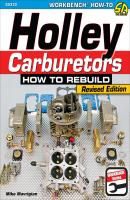Holley Carburetors. Mike Mavrigian
Чтение книги онлайн.

Читать онлайн книгу Holley Carburetors - Mike Mavrigian страница 10
Название: Holley Carburetors
Автор: Mike Mavrigian
Издательство: Ingram
Жанр: Сделай Сам
isbn: 9781613253144
isbn:
Venturi boosters come in different designs. These are “down-leg” boosters; note the angle of the passage body. The inside of the booster air passage hole is a small fuel orifice.
The fuel hole in this straight-leg booster is located on the underside of the small passage pipe that runs through the center of the booster air passage.
This 4500 Dominator is equipped with annular boosters. The inside of the booster’s main air passage has a series of fuel orifices that runs around the inside diameter of the air passage.
Here, you can see some of the small fuel orifices inside the annular booster.
Several booster designs have been used in Holley carburetors. They provide more or less restriction; signal strength increases as restriction increases, and this affects the pressure drop. In addition, fuel distribution and degree of atomization vary according to the signal.
A “standard” booster used today has a straight leg and a single small orifice passage for fuel entry into the booster’s cavity. A “down-leg” booster includes an angled leg, which provides less restriction.
Annular boosters, found in some 4150 series and all 4500 Dominator carbs, have a series of small orifices around the inside of the booster. They create a stronger signal that is especially useful with engines that have long-duration camshafts and low manifold vacuum at low engine speeds.
Holley carbs come in many designs. The 4160s have a fuel inlet at the primary bowl; a transfer tube then supplies fuel to the secondary bowl. The 4150s include dual fuel inlets, with an inlet at each bowl. Fuel travels through the needle and seat assembly and the bowl fills.
Regardless of series, as the fuel level inside the bowl rises, the float rises. Pressure from the float causes the needle to seat, cutting off the fuel flow. As the engine uses the fuel, the fuel level drops, lowering the float. Pressure from the dropping float unseats the needle, allowing fuel to flow into the bowl once again. The float level must be adjusted correctly so that the basic fuel metering system operates as designed.
On carburetors equipped with center-hung floats, float adjustment is handled externally via needle height adjustment. To make an adjustment, loosen the slotted plug (which is the lock), turn the hex to make the adjustment, and then tighten the lock. A sight port on the side of the fuel bowl allows you to monitor fuel height while the engine idles.
This close-up of a side-hung float clearly shows how the needle and seat assembly contact the float lever arm.
Here is a center-hung float in a 4150 fuel bowl. The needle and seat assembly contact the top of the float, which hinges from a center-mounted location. This style provides more consistent float and fuel level in the bowl during both acceleration and lateral maneuvers.
The top of the main body has air-bleed orifices on both the primary and the secondary sides of a 4150- or 4500-series carb. The outboard brass holes are for the primary idle air bleeds.
Although the air bleeds on most carbs are press-fit, the 4500-series Dominators have slotted and replaceable air bleeds for fine-tuning. Using larger diameter orifices creates a leaner air/fuel mixture.
The locations of the air bleeds on the Dominator are the same as on other models. The inboard holes are the high-speed bleeds, and the outboard holes are for primary idle air bleed.
Center-hung float bowls have a needle and seat assembly located at the top center of the bowl. The fuel inlet is located on the passenger side of the bowl.
The hex nut engages to the needle and seat assembly via a rectangular engagement. A 5/8-inch wrench is required to drive the hex nut. Turning the hex nut clockwise raises the needle and turning the nut counterclockwise lowers the needle. Whenever the hex nut is removed, always inspect the gasket on the underside of the nut and replace if it is damaged. A slotted screw serves only to lock the nut in place.
Removing or installing the needle and seat assembly must be done with care to avoid damaging the assembly’s O-ring.
Some carbs have a brass screw-in plug that must be removed. Fuel level is adjusted until the fuel is at the bottom of the sight hole. Other models have a glass sight window, which allows you to observe the fuel level without having to remove a plug. On 4160s with side-hung floats, the fuel bowl must be removed and turned upside-down; adjust the float so that the top of the float surface is parallel to the roof of the bowl.
This is a front view of a metering block equipped with main jets. The slot on each jet allows servicing with a flat-blade screwdriver, although a dedicated Holley jet driver is preferred because it avoids accidental slot deformation. See Chapter 4 for information about specialty carburetor tools.
Main jets are available in a wide range of orifice sizes. All jets share the same exterior shape, size, and thread. A selection of jet sizes is shown here, threaded into a billet aluminum jet card from AED. A jet organizer such as this allows a neat and orderly method of storing extra jets if you plan extensive tuning.
Each fuel bowl is vented internally to the air horn by a vertical vent tube in the main body, which allows the release of excess fuel vapor.
Screw-in metering СКАЧАТЬ